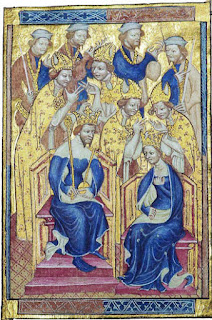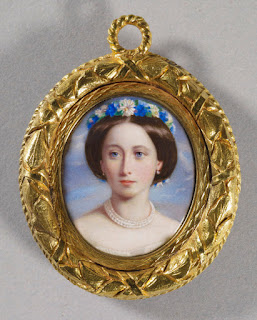Henry Plantagenet, or Henry of Winchester (due to his birth place) became King Henry III of England with the death of his father, King John, at the year of 1216. Henry III's reign is most remembered for the continuing First Baron's War, some rebellions supported and leaded by Prince Louis of France, the reinforcement of the use of Magna Carta and the prosecutions to the jews. But it's this latter that will be approached on this post.
Henry III was crowned at the age of nine, the first English monarch to have been crowned in a tender age. Named after his grandfather, the great lion of England King Henry II, Henry had inherited from his father a kingdom fragiled by the failures of his predecessor. England was destroyed by another Civil War and it would have not see an end for a while. Although followed by many misfortunes that marked his reign, though his efforts in trying to keep peace were not always successful. As said in this fragment, "historian David Carpenter judges Henry to have been a decent man, who failed as a ruler due to his naivety and inability to produce realistic plans for reform, a theme echoed by Huw Ridgeway, who also notes his unworldliness and inability to manage his court, but who considers him to have been "essentially a man of peace, kind, and merciful.""
However, it's not up to us to make a general observance of his reign or to point out the characteristic of Henry's character, but to emphasize the social aspects that clashed both worlds: religion and society. In Middle Ages, those two were not well separated or defined, being very often confused. The history of Catholic Church has been, since its recognition as heir to the late Roman Empire, full of ups and downs when it comes to its building and when it comes to medieval societies with personal bounds were not so different. In fact, with the Carolingian Empire, and even afterwards, the influence the Church had upon every believer especially with canonization to reach the lowest strata to make Catholicism an unique religion in Europe did not face opposition in England.
With that in mind, it must be remembered that relationship between Henry and the Church was reinforced in his early reign, when the Baron's War was still going and the young king needed support to reinforce his claim to the throne. So "(...) where Henry gave homage to the Papacy, recognising the Pope as his feudal lord. Pope Honorius declared that Henry was the Pope's vassal and ward, and that the legate had complete authority to protect Henry and his kingdom. As an additional measure, Henry took the cross, declaring himself a crusader and so entitled to special protection from Rome." This meant that, towards the rebels, the threat of excommungation could be used if they did not obey their king, with the Bishop of Winchester declaring a crusade against them.
And how did the jews become involved in this? Now we know how close was the relationship between Rome and England and how pious Henry III was, it is well to remember that, previously, in the last year of King John's reign, "Innocent III had (...) caused the Fourth Council of the Lateran to pass the law enforcing the Badge upon the Jews; and in 1218 Stephen Langton, Archbishop of Canterbury, brought it into operation in England, the badge taking the form of an oblong white patch of two finger-lengths by four."
Historically speaking, the jews had always been under royal protection, suspiciously for bringing the English monarchs money benefits, in the zone of trade most of times. But under the rule of Henry III, the jews were forced to pay £70,000 and expelled from many towns. It would not be until 1753 they would feel safe in English territory, being able to live without any sort of prosecution.
Sociologically speaking, religion was the moral, the law of any society of those days; and having Catholicism been established in most of european realms, naturally it would be their faith the rulers would turn into to make their will uncontested. The problem with the jewish was that, with receiving the blame for the death of Jesus Christ and as well not being part of Christianism, with the increase of prosecutions they had no place to call their home. Particularly, we can apply the concept of foreigner, as said by sociologist author Alfred Schutz in his essay about the "stranger|": "The term 'foreigner' shall mean an adult individual (...) that tries to be permanently accepted or at least tolerated by the group to which he approaches." Lacking this capacity in belonging to a society that rejects them, the jews turned to live atthe margins of society.
The best example to illustrate the case is the most horrible and shocking about this Christian boy named Hugh who disappeared in Linconlshire and was crucified by the jews. A better description is found in this fragment below:
"The supposed crucifixion in 1255 of a little Christian boy by the Jews of Lincoln, in macabre parody of the crucifixion of Christ, was for Jews and Christians alike, although for very different reasons, one of the most shocking events in the reign of King Henry III. For the Jews it had appalling consequences. One named Copin, who confessed to the crime, was hung, having first been tied to the tail of a horse and dragged for a long time through the streets of Lincoln, his body becoming broken and lacerated with stones. A little later, eighteen more Jews suffered the same fate in London. Meanwhile, the body of the 'vicim' had been laid to rest by the dean and canons of Lincoln in the cathedral, where it performed miracles and became known as 'Little Saint Hugh'. The episode inspired a contemporary ballad in 367 lines of French verse. (...) Matthew Paris's account took up three pages and appeared as a continuous narrative from June through till November, instead of being broken up, in his normal fasshion (...), a good indication of the story's riveting effect."
This anti-jew feeling only helped to make the Crown independent of the services the jewish in matters of trade, finding other means to supply their economical needs, by taking into his kingdom italians merchants, who had not only access to products from east but from Rome's mesures as well. But the sad event not only had tragic consequences as would later culminate to their fully expelling in 1290, under the reign of Edward I.
What we can see from the direct involvement of the king in judging the case of Young Hugh is that "Langmuir's main point was that Henry III's trial and conviction of the Jews represented the first occasion on which any European ruler had affirmed the truth of such allegations. And even today, it gives one a start, to read in Henry III's letters of this 'horrible crime' and of an 'infant lately crucified'. All this added to the toxic mix of prejudice and profit which was to lead to the eventual expulsion of the Jews from England in 1290".
What we can observe of religion, politics and society in that particular moment is that, whether it is accepted or not, the necessity of classifying and including people and their culture into Christianity was clear enough when this same concept excluded the jews, making them for so long living in diaspora. The role of a monarch and his direct connection with Rome proves that, though the king is the one to have the last word before any order is followed, it is his faith that, when correctly guided, leads him doing so. If Henry III is personally guilty or not, that is hard to say. For he was, independently of our personal views of the society we live nowadays, a social product of his days.
Sources: "The Stranger: An Essay in Social Psychology ", SCHUTZ, Alfred; 118.
http://www.finerollshenry3.org.uk/content/month/fm-01-2010.html
https://en.wikipedia.org/wiki/History_of_the_Jews_in_England_(1066%E2%80%931290)#Under_John.2C_1205.E2.80.931216
http://www.oxfordjewishheritage.co.uk/english-jewish-heritage/68-english-jewish-heritage
http://www.finerollshenry3.org.uk/redist/pdf/Jews.pdf
https://en.wikipedia.org/wiki/Henry_III_of_England





















